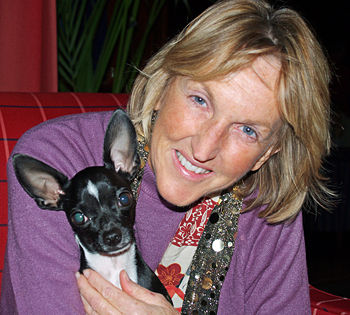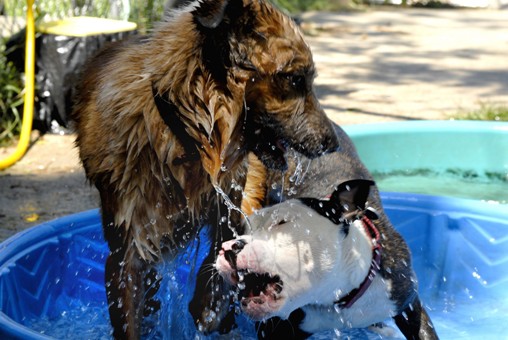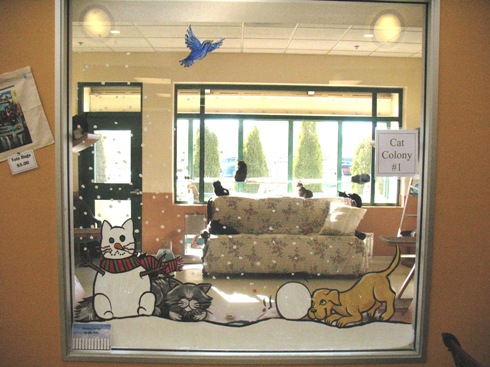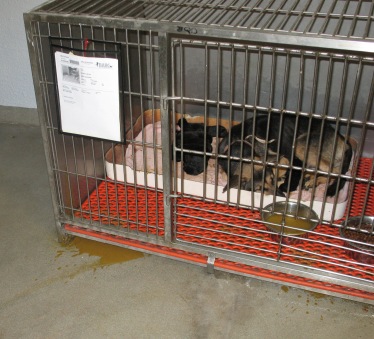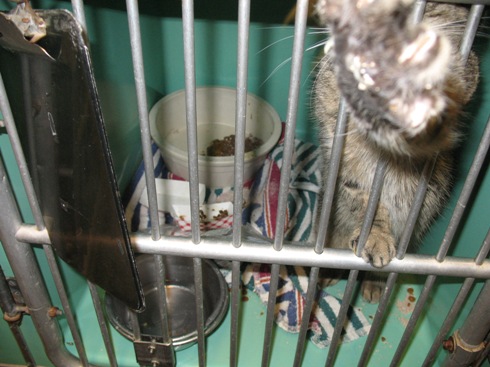Ingrid Newkirk is the Butcher of Norfolk. The whereabouts of this little dog are unknown. If his fate is anything like 97% of the animals PETA seeks out every year, his lifeless body is in PETA’s freezer.
Attention: Dog and cat killers. Ingrid Newkirk of PETA would like to protect you, shield you, promote you, and defend you. There is only one criterion: call yourself an animal shelter. It doesn’t matter if you kill in the face of readily available lifesaving alternatives. Why should it? They do the same, every single day.
It doesn’t matter if you neglect and abuse them before you kill them. It doesn’t matter if you don’t feed them, it doesn’t matter if you allow puppies to drown in drains, and it doesn’t even matter if you beat them to death. PETA will champion your cause.
They will write letters to the editor for you. They will write Op Ed pieces for you. They will attack anyone who criticizes you. They will threaten lawsuits. Whatever it takes. Because as long as you are needlessly killing animals and as long as you are claiming you have no choice but to do so because of “pet overpopulation,” you are providing Newkirk a valuable service. You are giving her political cover for her own dark impulses, which results in PETA seeking out and killing thousands of defenseless animals every year.
The latest salvo from the Butcher of Norfolk is an Op Ed piece in The Jersey Journal, in response to protests by animal lovers in that community, where she comes to the defense of the Liberty Humane Society’s (LHS) recent killing of animals. The Butcher cites Niki Dawson, the interim director at LHS, who stated that she arrived to find the shelter “abysmal, horrendous, shocking, horrifying: It’s difficult to put into words what it’s like to see 99 dogs crammed into a facility built to comfortably house only 50. What it’s like to witness 274 cats in a building meant for only 80. Perhaps the best description is a word we in this field know only so well: HOARDER.”
Dawson should know; she was accused of the same thing when she was forced out of Camden County’s shelter as the director. In fact, her successors used the same tactic in order to justify the killing of hundreds of animals there after she left. Dawson had more than the claimed capacity at Camden County, and the “excess” were simply executed. But the Dawson who was trying to save animals in Camden knew something that the one who was hired to kill them in Jersey City appears to have conveniently forgotten: it is not the number of animals in the facility per se, but the quality of their care.
The fact that a shelter was built for 50 dogs but has 99 means little if the dogs are kept clean, well-cared for, and socialized. And even if you were to accept her statement at face value, even if it was all true, LHS did not have to resort to the extreme, unethical, and cruel option of killing that the Butcher implies is the only logical recourse. They could have cleaned the cages they claimed were filthy. They could have socialized and fostered the animals they claimed were going crazy. They could have adopted out the ones they claimed were being warehoused. Dawson and I had an e-mail exchange over the numbers of animals at LHS. And in addition to sample flyers and promotions and a guide to increasing adoptions, I sent her the following on August 14:
While I see you have been reaching out to the rescue community, you need to reach out to the public. You are across the river from an adoption market of 8 million people, and Liberty’s surrounding suburbs are a good market for animals, and in that context, [finding homes for] less than 50 dogs and 200 cats is very doable. Keep in mind that in a community of 400,000 people, the [Nevada Humane Society is] adopting out 1,000 animals a month in Reno. The key is to reach out to the public in a positive, engaging way without the hoarder language you’ve been using to get the rescue community’s attention. There is no reason why you could not move the “excess” animals quickly through a positive marketing and adoption promotion, utilizing adoption venues in the shelter, throughout the community, and even, if need be, across the river. I am enclosing a packet of information which I hope will help. It includes adoption promotion ideas, marketing ideas, and more. It will come in two separate e-mails because of the size and amount of information.
Also, keep in mind that shelters can comfortably exceed capacity of design, as long as they do it smartly. There are over 500 animals on any given day at the NHS though the facility was not “built” to house that many but even veterinary critics who thought a shelter should not exceed design capacity changed their minds after visiting for themselves. As long as the animals are clean, well cared for, and socialized regularly, it’s not an issue. Most shelters, including all government agencies, have moved away from engineering standards toward performance standards. You can talk to Sue Cosby at the PSPCA how she comfortable housed animals in the garage, which was not built for animal holding, during a flu epidemic in the shelter so she did not have to kill. Again, the key is to use performance standards for animal well being.
You can literally see New York City, the largest City in the U.S. and a prime adoption market, from Liberty Park in Jersey City. That is eight million people on top of the 600,000 in Jersey City and Hudson County to appeal to for the adoption of 250 animals. They could have adopted all of them and more in a single weekend. But that is not what they chose to do. I went on Liberty Humane Society’s website today. They haven’t had an adoption promotion event since June, during the last administration. The next one is not until September 18, over one month after I suggested it. Feeble efforts lead to feeble results. But I guess it is just easier to scream “hoarder,” blame the past administration, and kill the animals. Just like Dawson’s successors in Camden County did to her.
The irony, of course, is that had anyone been protesting the Camden massacre, the Butcher would have condemned Dawson as a hoarder and come to their defense. But these are just facts. And, like I said, the Butcher is not going to let them get in the way of a sensationalist story. So what does the Butcher do? Lies to the readers of The Jersey Journal by suggesting homes are not available; that there are “far more dogs and cats than there are homes. Millions more.” To prove this, the Butcher of Norfolk does not offer statistics or data. She doesn’t even offer any analysis. How could she? It is, in fact, not true.
There are about 3,000,000 dogs and cats being killed because shelters do a lousy job at adoptions. In fact, some shelters don’t do any adoptions. Every year, however, over 21 million people are looking to bring home a new companion animal in the U.S., a number which is growing every year. Where will that new dog (or cat) come from? Some are already committed to adopting from shelters and they will do so. Others will go to a pet store, breeder, or other commercial-type source. But roughly 17 million people have not decided where their new pet will come from and studies show they have a positive view of shelters, are open to adopting from shelters, and can be convinced to do so. These are the people shelters need to reach to successfully adopt more animals to them. Even if roughly 80% of those people got a dog or cat from somewhere other than a shelter, we could still zero out the killing.
The problem is not a lack of homes, the problem is that the shelters the Butcher champions find killing easier than doing what is necessary to stop it. They simply refuse to innovate, modernize, and emulate the state-of-the-art sheltering protocols that progressive shelters have followed in order to revamp their adoption programs. Why? Because doing so takes dedication and effort, when it is so much easier to exploit the boogeyman of “hoarding” and use it to attack those who want to end the killing.
Never mind that the average length of stay for animals at the open admission animal control shelter I ran in New York was only eight days and that no animal ever celebrated an anniversary there. Never mind that the average length of stay at the open admission No Kill Nevada Humane Society, which adopts out 10,000 a year, is 14 days, or about a vacation-level stay for a dog in a boarding kennel. Are we really going to accept that these animals would be better off dead?
But, once again, don’t worry about the facts. They just get in the way. After all, the Butcher says, “PETA ran an ad pleading for homes for 28 cats. Three people responded.” First of all, this never happened. It is made up. If PETA is saying that despite $30,000,000 in revenues, millions of animal-loving members (who falsely believe that PETA is an animal rights organization), and a powerhouse media reach, they could not find homes for 28 cats, we have no choice but to dismiss such a claim as an absurdity and a lie. There are countless examples of shelters emptying their facilities by adoption when they reached out for help. And they do not have PETA’s media savvy, millions of supporters, and unlimited resources.
There is no doubt that the facility in Liberty is run down. There is no doubt that it is need of significant capitalization. The animal holding spaces are inadequate and the shelter is in disrepair. That is the byproduct of the “catch and kill” paradigm that does not value animals. The No Kill movement has redefined not just sheltering, but the actual physical shelters themselves. The No Kill movement has created facilities that eliminate stainless steel cages and chain link kennels. These new shelters are the physical manifestation of the right to life and quality care ethic embodied in the No Kill philosophy.
Compare these No Kill shelters with two killing shelters championed by PETA:
Dogs wait for adoption in Animal Ark’s spacious “kennels.” The physical shelter is reflective of how caring the programs and staff are there.
It’s play time at the Charlottesville SPCA. Good care and socialization are synonymous with the No Kill philosophy.
Cats lounge about and enjoy the sun and fresh air in this cat colony room at the Nevada Humane Society: a clean, caring, comfortable No Kill shelter.
A dog and puppies at Houston’s animal control shelter. Diarrhea is all over the cage floor and in the water bowl but is not cleaned. Shelter staff have allowed puppies to drown in the trench drain, kittens to go without food and water, and one employee beat a dog but was not fired. Employees who scored the lowest on city aptitude tests were placed in animal control. Read a report of conditions by clicking here. PETA has defended this shelter.
A cat begs for food at King County’s abusive pound. Cats were not fed during a long holiday weekend. An employee who came forward as a whistleblower was threatened with violence by union-protected staff. Read a report of conditions by clicking here. PETA told the County Council not to listen to “radicals” who want to improve conditions.
Who really cares about the animals?
But despite the infrastructure challenges at LHS, they are not responsible for the recent spate of killings. Nor can the dirty shelter be blamed. All of that could have been addressed without the needle. It is a little something I like to call “cleaning.” And a little something else I like to call “adoption.” It means marketing your animals, not just once every three months as LHS is doing, but every weekend, every day, to the millions of people who surround you and love animals. You know, those Americans who spend $50 billion a year on their companion animals, who miss work when they get sick, who keep pictures of them in their wallets. The very people the Butcher accuses of being irresponsible and uncaring, even though they send her organization $30,000,000 a year in donations, falsely believing that she will use that money to save animals, not kill them herself and promote their killing by others.
Once again, it is so much easier to lie. To falsely claim, as the Butcher does, that most pounds in this country are good places, where animals receive loving care, and that the No Kill movement is a threat to these wonderful institutions. As the thousands of dedicated activists nationwide working to reform their community’s abusive, medieval shelters can attest, the reality is that “shelters” across the countries are not just needlessly killing; they are neglecting and abusing animals before they put them to death.
We have inherited a paradigm of neglect and killing, of built in excuses that have allowed governments to underfund their shelters, that have allowed wealthy humane societies to kill animals while hoarding the millions of dollars given by animal lovers to care for the animals, that have allowed cities like Houston, the fourth largest in the U.S., to appoint people who score the lowest on city aptitude tests to the animal shelter and then allow them to keep working even when they beat dogs to death (a shelter PETA has openly defended). And in fact, the so-called “professionals” who work there are not only lazy and inept, they are ignorant of basic protocols: of how to clean and disinfect, of how to keep animals moving efficiently through the system and into loving, new homes, of how to keep them healthy. Even if they did know, many of them wouldn’t care. But the reality is that they do not know, because teaching them and then holding them accountable to those protocols are not a priority for uncaring government bureaucrats and were never a priority for the large national organizations which are supposed to provide oversight, but do not. Instead, they just legitimize the poor care and killing, by blaming the “irresponsible public” and “pet overpopulation.”
And PETA never says a word. Never complains. Doesn’t hold them accountable. In fact, when they do comment, it is to defend these facilities. It is only when someone takes over that kind of shelter and tries to end the killing that the Butcher stands up and says, “Look, the facility is dirty. No Kill is to blame.” Her conclusion: “Municipalities need to stand firm.” They need to continue killing in the face of alternatives. They need to keep passing punitive laws that are not funded, that cause poor people to relinquish their animals, that cause killing to increase wherever they are passed. Because, in her warped, deluded, twisted way of thinking, the movement to end killing, to provide better care, to build more humane shelters, is the problem. And it is easy to see why she wants people to think so.
If the No Kill movement succeeds, and the killing of animals is no longer legitimized by blaming the public and overpopulation; if, in fact, it is no longer done, then her own killing of thousands of animals every year loses its political cover. It will be universally regarded as the needless slaughter it really is, and the sickening manifestation of a deeply disturbed individual. And how will she ever get away with it then?
———————–
YesBiscuit! broke the story first. Read more by clicking here.
